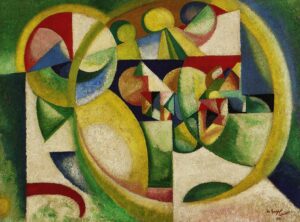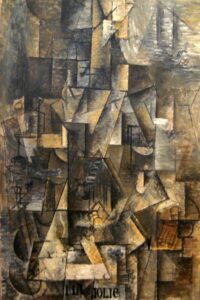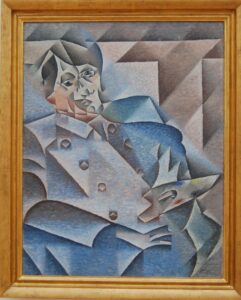Analytic Cubism marks a revolutionary turn in the art world, breaking from traditional perspectives and delving into fragmented, abstract forms.
It’s a style that challenges our perception, urging us to see beyond the surface and piece together new meanings from the geometric shards.
In this article, we’ll explore the origins and characteristics of Analytic Cubism, a movement spearheaded by Pablo Picasso and Georges Braque.
We’ll uncover how they deconstructed reality on canvas, setting the stage for modern art as we know it.
Join us as we dissect the complex layers of Analytic Cubism and its enduring impact on the art landscape.
Origins Of Analytic Cubism
Analytic Cubism, a term coined after the fact, originated in France in the early 20th century.
We credit this movement primarily to the joint efforts of Pablo Picasso and Georges Braque, who sought a new approach to painting that diverted from the Renaissance era’s calls for naturalism and illusionistic space.
This groundbreaking movement emerged strongly between 1907 and 1914, a period during which both cubic virtuosos embarked on their artistic adventures.
Their pioneering works, such as Braque’s Houses at L’Estaque and Picasso’s Les Demoiselles d’Avignon, challenged the conventional visual narrative by introducing a radical visual language.
Characteristics Included:
- Fragmented objects and spaces,
- Use of monochromatic color palettes,
- Introduction of multiple perspectives within a single plane.
Their collaborative venture was bolstered by intellectual discussions and a shared interest in the works of Paul Cézanne.
Cézanne’s post-Impressionist work laid essential groundwork for the Cubist movement as he explored geometric simplification in his own paintings – an approach that resonated deeply with Picasso and Braque.
The abandonment of traditional perspective wasn’t arbitrary.
Both artists aimed to represent the complexity of the visible world, exemplifying that a single point of view was no longer sufficient.
By breaking down objects into geometric forms and reassembling them from multiple viewpoints, they offered viewers an experience that was more about analysis and less about visual pleasure.

Our understanding of this influential art period deepens when we consider the significant cultural and philosophical shifts taking place during the early 1900s.
These developments dovetailed perfectly with the emergence of Analytic Cubism, marking the beginning of a new epoch in the art-world whose effects are still reverberating through contemporary works.
Characteristics Of Analytic Cubism
Analytic Cubism is distinguished by several key attributes that allow it to stand out as a unique art movement.
The primary characteristics involve a fragmented and geometric breaking down of objects, enabling us to see multiple angles simultaneously.
This multiplicity of viewpoints rejects the single perspective held by traditional art forms, thereby creating a more immersive visual experience.
In these compositions, artists like Picasso and Braque would often limit their color palettes, favoring monochromatic tones.
The restriction in color enhances the focus on structure and form.
This tonal similarity across the canvas allows the play of light and shadow to become more prominent, offering depth and volume to the flattened shapes.

The artists would use:
- Collage elements,
- Sand or sawdust for texture,
- Simulated wood grain or marbling.
These materials and techniques challenge the viewer’s perception, blurring the lines between two-dimensional space and three-dimensional representation.
Another intriguing aspect of Analytic Cubism is the overlapping of planes and facets.
A single object might be broken down into a series of shifting planes, each one offering a different facet of the whole.
This technique creates a dynamic tension within the canvas as our eyes work to piece together the fragmented images.
In works such as Les Demoiselles d’Avignon and Man with a Violin, we witness the revolutionary approach to composition that exemplifies the movement.
Analytic Cubism showed us that the surface of a canvas could be reimagined as a complex puzzle, where spatial relationships and forms intersect and disconnect, conveying a deeper sense of reality beyond mere appearance.
Pablo Picasso And Georges Braque: Pioneers Of Analytic Cubism
Pablo Picasso and Georges Braque are hailed as the forefathers of Analytic Cubism, an art form they jointly developed.
Their collaboration began in 1907, following Picasso’s unveiling of Les Demoiselles d’Avignon, a painting that marked a radical break from traditional representation and set the stage for Cubism’s evolution.
Braque responded with his own avant-garde piece, Houses at L’Estaque, which further distilled shapes into their geometric components.
Together, Picasso and Braque pushed past the boundaries of classical art, ushering in a new era of painting.
The interplay of their ideas and styles is evident in the work they produced during the peak of Analytic Cubism between 1909 and 1912.
Each artist would contribute to a constantly evolving dialogue:
- The flattening of the space and the interlocking planes,
- The integration of multiple viewpoints into a single composition,
- The reduction of color to a nearly monochromatic scale to emphasize structure.
This exchange of creative energies led to a prolific output of paintings that defied traditional techniques and reframed visual storytelling.
Picasso’s Portrait of Ambroise Vollard and Braque’s Violin and Candlestick are quintessential examples, demonstrating the dismantling of form and the complex assembly of fragmented perspectives.
Our examination of their artworks reveals an intricate choreography of shapes and lines.
The use of letters and stenciled words in some of their compositions hints at a nascent interest in what would later bloom into Synthetic Cubism, yet they maintained a rigorous focus on the analytic deconstruction of objects.
Each canvas from this period can be seen as a study in the radical analysis of form, shadow, and light, inviting viewers to reassemble an image through their own perception.
By deliberately obscuring the subject and embracing ambiguity, Picasso and Braque forged a visual language that questioned the very nature of representation.
Their shared commitment to Analytic Cubism not only altered their own artistic paths but also cast a long shadow over the future of art, opening doors for abstraction and influencing countless artists who followed in their wake.
Deconstructing Reality: Techniques Of Analytic Cubism
Analytic Cubism was a revolutionary turn in the history of art, where traditional single-point perspective gave way to a multi-faceted view of objects and shapes.
In transitioning from representational to conceptual, we observe how artists like Picasso and Braque reinterpreted the world around them.
Faceting was a technique we see utilized in their works, allowing objects to be broken down into geometric shapes.
These fragmented forms were then meticulously reassembled on canvas, introducing a rhythm of interlocking planes and angles.
The technique bestowed a sense of depth and dimension without relying on traditional Renaissance perspective.
Monochromatic Color Palette and Subtle Shading:
- To emphasize structure over color,
- Shift focus from realistic representation to form and geometry.
By limiting their palette largely to neutrals, Picasso and Braque directed our gaze to the stark structural elements of the subject.
Bold shading techniques increased the dynamism within each composition, highlighting the transformative power of light and shadow in modeling form.
With the introduction of Simultaneous Perspectives, objects in Analytic Cubist works were depicted from multiple angles at once.
This approach allowed us to piece together varied visual information, producing a more comprehensive understanding of the subject’s form in space.
It was not just a stylistic choice but an intellectual one, challenging us to consider the fluidity of reality.
The meticulous technique of Passage blurred the distinction between the foreground and background.
By merging forms, the artists created a cohesive interplay that encouraged our eyes to roam across the entire canvas and discover continuities and disruptions.
This seamless integration pushed us to see the unity even within fragmentation.
In exploring these innovative techniques, Picasso and Braque ceased merely to reflect the visual world but instead invited us into an intimate dialogue with it.
Here, they didn’t just deconstruct reality; they reconstructed it into a language of shapes and shaded forms, allowing us to reconstruct the scene ourselves, piece by geometric piece.
Legacy And Impact Of Analytic Cubism
The groundbreaking approach of Analytic Cubism had profound ramifications well beyond the canvas.
It’s not an overstatement to say that the movement reshaped the trajectory of modern art.
Artists from all corners of the globe were inspired to experiment with form and to question the very nature of representation in art.
Influence on Subsequent Art Movements
- Many subsequent art movements, including Constructivism, De Stijl, and Futurism, took cues from the Cubist vocabulary. These movements pushed the boundaries of abstraction even further.
- Later abstract artists, like Jackson Pollock and Mark Rothko, can trace a philosophical lineage back to Cubism’s disruptions of traditional artistic conventions.
Several key elements of Analytic Cubism have been incorporated into myriad aspects of modern culture.
These elements include:
- Fragmentation: This principle made its way into the narrative structures of modern literature and the montage techniques of film making.
- Multiple Perspectives: Pioneering the use of simultaneous perspectives influenced not only visual arts but also shaped the avant-garde literature and theater.
Masterpieces such as Les Demoiselles d’Avignon and Guernica by Picasso, and Braque’s Violin and Candlestick, continue to resonate in contemporary discussions about the nature of reality and perception.
These artworks serve as enduring testaments to the power and relevance of Cubist ideas within the art historical canon and popular culture.
Cubism’s legacy is also evident in design, where the abstracted forms and geometric structures have influenced everything from furniture to fashion.
The echoes of Cubist philosophy continue to reverberate in the sleek lines of modern architecture and the user interface of digital media, proving that the movement’s core principles are as adaptable as they are groundbreaking.
Analytic Cubism – Wrap Up
We’ve seen how Analytic Cubism has been a pivotal force in redefining artistic boundaries.
Its echoes are still felt across various creative disciplines today.
As we reflect on its enduring influence, we’re reminded that the revolutionary ideas of Picasso and Braque aren’t just historical footnotes but living principles that continue to challenge and inspire.
Their work ensures that our exploration of reality through art remains as dynamic and multifaceted as the perspectives they once fragmented on their canvases.

Frequently Asked Questions
What Is Analytic Cubism?
Analytic Cubism is an avant-garde art movement developed by Picasso and Braque, characterized by the fragmentation of objects into geometric forms and the representation of multiple perspectives simultaneously within a single artwork.
How Did Analytic Cubism Impact Modern Art?
Analytic Cubism significantly impacted modern art by encouraging artists to experiment with form and representation, ultimately leading to the development of other art movements like Constructivism, De Stijl, and Futurism.
Who Were The Main Artists Associated With Analytic Cubism?
Pablo Picasso and Georges Braque are the primary artists associated with Analytic Cubism, having developed the style and produced some of the most noteworthy works in this movement.
In What Ways Has Analytic Cubism Influenced Modern Literature And Film?
Analytic Cubism has influenced modern literature and filmmaking by introducing narrative techniques that incorporate fragmentation and multiple perspectives, often challenging traditional storytelling methods.
Are Elements Of Analytic Cubism Present In Today’s Art And Design?
Yes, elements of Analytic Cubism, such as the use of geometric forms and the inclusion of multiple viewpoints, are evident in contemporary design, architecture, and digital media.
How Do The Masterpieces Of Picasso And Braque Remain Relevant Today?
The masterpieces of Picasso and Braque continue to be relevant by influencing contemporary discussions on reality and perception and by being a source of inspiration for artists and designers exploring cubist principles in their work.


